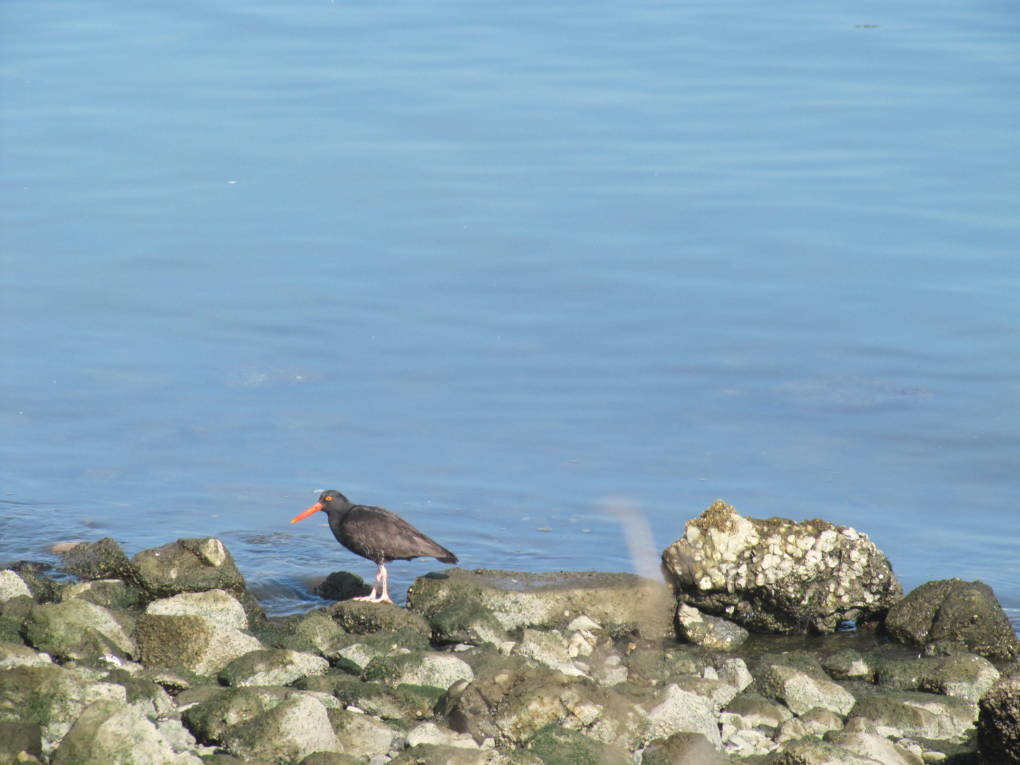Shorebirds, especially, are imperiled by rising seas and habitat loss

More than one hundred species of California’s birds are vulnerable to the effects of climate change. Scientists at the California Department of Fish and Game and PRBO Conservation Science examined nearly 400 species and subspecies for a study, released today. Of those, 128 are at risk.
San Francisco Bay is home to the majority of the most vulnerable birds. “That’s primarily because of sea level rise and also because there are already so many imperiled species that use that habitat in the bay,” says Tom Gardali, an ecologist is PRBO Conservation Science.
Those species include the endangered California Clapper Rail and three song sparrows found only in the Bay Area. “With sea level rise, the habitat that exists could be underwater if there’s no place for it to grow into because of development,” says Gardali. Birds that inhabit rocky coastline could also be at risk for the same reason, including the Black Oystercatcher, Common Murre, and Pigeon Guillemot.
[module align=”left” width=”half” type=”aside”]
Birds Species Most Vulnerable
to Climate Change in California
Greater Sage-Grouse
California Least Tern
California Clapper Rail
Suisun Song Sparrow
Samuel’s Song Sparrow
Alameda Song Sparrow
Yellow Rail (winter)
California Black Rail
Yuma Clapper Rail
Black Oystercatcher
Marbled Murrelet
Scott’s Oriole
Elf Owl [/module]
Twenty-one of the state’s 29 threatened and endangered species are on the list. “It is more than likely that some of these species are already feeling the effects of climate change,” he says. “Massive changes to the ocean foods web could very well be a direct effect of climate change, as well as prolonged droughts or droughts more frequently.”
Garbali says the California Department of Fish and Game will use the date to update their list of species of special concern, which hasn’t included climate change effects to date. The agency could use also the information in revising the California Wildlife Action Plan. “State and federal agencies will consider the threat of climate change. That will become business as usual. It will have to be.”
“I think you could see this study as an opportunity to start planning now and we have time to make a difference for California’s biodiversity,” says Gardali.
6 thoughts on “New List Highlights California’s Birds Most Threatened by Climate Change”
Comments are closed.


You should include the threatened and endangered grassland species that are at risk from the rush for industrial-scale solar energy projects such as the one proposed for the Important Bird Area of Global Concern, Panoche Valley.
New survey conducted by the Daily Beak shows 9 out 10 birds choose gradual climate change over sudden butchery by wind turbine. When primary forager involved, survival of entire nest in imminent peril. Coastline dwellers say some have already “kamkazied out” in advance of reported sea level rise.
If there were real LEGAL consequences
for condemning billions of children to CO2 demise, none of you remaining
doomers would still be shooting your mouths off like this about any CLIMATE
CRISIS. Pollution is real, we get it. But to hold the CO2 spear of fear to our
children’s backs was beneath us all. REAL planet lovers are happy, not
disappointed a Human CO2 climate crisis was exaggerated and not real after all.
Clearly, extinction of species is a topic that will energize debate about climate change. If events continue to point to global warming as an existential threat to all species, including humans, public opinion will come to demand action. The west slope of Antarctica is ground zero for concern about significant, rapid sea level rises because of global warming. I offer a very ambitious and action-oriented proposal at http://dolphinblueinc.wordpress.com/2009/09/23/proposed-effort-to-slow-melting-of-glacier-in-antarctica/ for how melting of ice in Antarctica could be slowed. Absent a slow-down or halt in a rise in sea level of an estimated one meter by 2100, upwards of 500 million people will be displaced and coastal cities and huge swaths of low-lying land areas will be inundated and made unproductive. The solution I propose would be extraordinarily costly, but the costs would be smaller than the ultimate price of inaction. If every nation in the world would accept global warming as an existential threat, solutions could be implemented that are commensurate with the threat. A budget of $2 trillion per year
(approximately what is spent on wars and military preparedness) would do the job. See
http://www.dolphinblue.com/pg-Update–Energy-Island-a-Solution-to-Global-Warming.html for an
update on the feasibility of my ocean-based solution.
This is alarmist rubbish, there is no evidence of appreciable sea-level rise in the past 50 years: http://fullcomment.nationalpost.com/2011/10/14/lorne-gunter-global-warming-is-the-least-of-tuvalus-worries/
“That’s primarily because of sea level rise and also because there are already so many imperiled species that use that habitat in the bay,” says Tom Gardali, an ecologist is PRBO Conservation Science.
Oh no,,, we are being overrun with imperiled species…So Funny..
Too bad birds don’t have wings, then they could just fly away.